Diabetes英文版糖尿病病因症状及对症
- 格式:ppt
- 大小:3.44 MB
- 文档页数:7

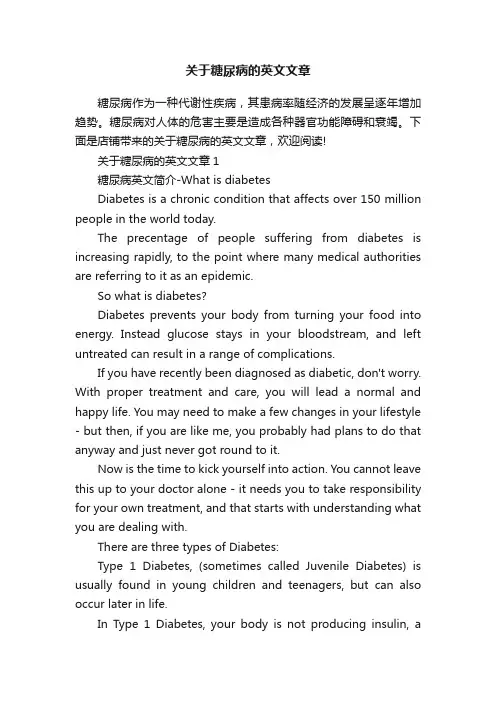
关于糖尿病的英文文章糖尿病作为一种代谢性疾病,其患病率随经济的发展呈逐年增加趋势。
糖尿病对人体的危害主要是造成各种器官功能障碍和衰竭。
下面是店铺带来的关于糖尿病的英文文章,欢迎阅读!关于糖尿病的英文文章1糖尿病英文简介-What is diabetesDiabetes is a chronic condition that affects over 150 million people in the world today.The precentage of people suffering from diabetes is increasing rapidly, to the point where many medical authorities are referring to it as an epidemic.So what is diabetes?Diabetes prevents your body from turning your food into energy. Instead glucose stays in your bloodstream, and left untreated can result in a range of complications.If you have recently been diagnosed as diabetic, don't worry. With proper treatment and care, you will lead a normal and happy life. You may need to make a few changes in your lifestyle - but then, if you are like me, you probably had plans to do that anyway and just never got round to it.Now is the time to kick yourself into action. You cannot leave this up to your doctor alone - it needs you to take responsibility for your own treatment, and that starts with understanding what you are dealing with.There are three types of Diabetes:Type 1 Diabetes, (sometimes called Juvenile Diabetes) is usually found in young children and teenagers, but can also occur later in life.In Type 1 Diabetes, your body is not producing insulin, ahormone needed to convert blood sugar into energy. Normally this hormone is produced by cells in your pancreas, but for some reason this is not happening as it should.As the glucose in your blood can't be converted into energy and absorbed by your cells, it builds up causing high blood sugar.Left untreated, high blood sugar can cause serious long-term health problems.The normal treatment for people with type 1 diabetes is daily injections of insulin which keeps the blood sugar level within normal ranges.Finding out you have diabetes can be upsetting, but it should not prevent you from living a long and happy life.If you think this condition will prevent you leading an active life, consider Sir Steve Redgrave, one of the World's greatest Olympic athletes.Sir Steve battled type 1 diabetes to win his record-breaking fifth Olympic Gold medal at the Sydney games in the coxless fours rowing event!Type 2 diabetes (sometimes called mature onset diabetes) is the most common form of diabetes.As with Type 1 Diabetes, the problem is related to insulin, a hormone needed to convert sugar into energy.With Type 2 diabetes your body might be producing too little insulin, or it might not be reacting to the insulin correctly. Either way, the end result is that glucose builds up in the bloodstream instead of going into the cells. Left untreated, high blood sugar can cause serious long-term health problems.Type 2 diabetes usually appears later in life, often between the ages of 35-45 years. As it often develops slowly, many people may not recognise the symptoms, and may have diabeteswithout knowing it.If you have recently been diagnosed with type 2 diabetes, you are one of the lucky ones. Many people have diabetes without knowing it, and are at much greater risk of long term medical complications.Finding out you have diabetes can be upsetting, but it should not prevent you from living a long and happy life. You may need to make a few changes in your lifestyle, but these changes are also good advice for non-diabetics, so probably a good idea anyway.Gestational diabetes is a type of diabetes, that is only suffered by pregnant women.In Gestational diabetes, a woman’s blood sugar is hig her than normal because of the other hormones pridcued during preganancy interfere with the insulin that is produced naturally.Gestational diabetes usually becomes apparent during the 24th to 28th weeks of pregnancy, and, in most cases, disappears of its own accord once the baby is born.Women with gestational diabetes usually do NOT have an increased risk of having a baby with birth defects.Generally, sufferers of gestational diabetes have normal blood sugar levels during the critical first stages of the preganancy.Whilst there can be complications caused by gestational diabetes, these can usually be managed by careful attention to nutrition and blood sugar levels.Approximately 3 to 5 percent of all pregnant women in the developed world suffer from gestational diabetes.关于糖尿病的英文文章2医学英语糖尿病专业词汇A1C –Hemoglobin A1c 醣化血色素A-II receptor antagonist/blockers-ARA [ARB]血管张力素II 接受体拮抗剂/阻断剂A chain,insulin, 胰岛素α链Acanthosis nigrans, 皮肤棘状黑色素瘤Acarbose,一种α-葡萄苷酶抑制剂 ,Acarbose [Glucobay-Bayer] Accountability measures 质量改善度评量ACCU-Check Compact-Roche Diabetes Monitoring Kit 一种携带型血糖机Accupril --Quinapril [Acupril-Parke Davis]之商品名ACEI=ACE inhibitor 血管张力素转化酶抑制剂 [ACEI 非正式名词] ACE inhibitors 血管张力素转化酶抑制剂ACE-K煮甜甜--Acesulfame Potassium [煮甜甜—益富]一种Sweatener 甜味矫味剂Aceon--Perindopril [Aceon-Solvay] [Acertil-Servier]一种血管张力素转换酶抑制剂Acertil--Perindopril [Aceon-Solvay] [Acertil-Servier]一种血管张力素转换酶抑制剂Acesulfame Potassium =ACE-K [煮甜甜—益富]- 一种Sweatener 甜味矫味剂,Adalat--Nifedipine [Adalat-Bayer] [Adalat OROS-Bayer] 一种钙离子径路阻断剂Adalat OROS--Nifedipine[Adalat OROS-Bayer]一种钙离子径路阻断剂长效型Adhesion molecule 黏着分子与动脉硬化形成有关,可被HDL 抑制Acertil --Perinodopril [Acertil-Servier]商品名,属于ACE inhibitor用于糖尿肾病变Acetoacetate 乙酰乙酸盐乙酰醋酸Acetohexamide 口服降糖药物 Acetohexamide [Dymelor-Lilly]Acetone 丙酮Acetylsalicylic acid: [Aspirin-Bayer],乙酰水杨酸,阿司匹林Acidosis 酸血症Acipimox [Olbetam-Pharmacia] 烟碱酸类降脂剂Acromegaly肢端肥大症Action--Insulin 胰岛素之作用Actos –Pioglitazone,Insulin sensitizer胰岛素敏感度反应性增强剂新降血糖药物Actrapid Human Insulin-Novo Regular, Human insulin快速作用型人体胰岛素Acute myocardial infarction急性心肌梗塞ADA=American Diabetes Association 美国糖尿病学会Additive--Insulin胰岛素制剂之添加剂ADDQOL=Adult of Diabetes Dependent QOL成人糖尿病相应生活质量Adhesion--Insulin 胰岛素沾粘性Adrenergic blockers交感神经阻断剂Aducut--Delapril [Adecut-武田] 一种血管张力素转换酶抑制剂Adult of Diabetes Dependent QOL=ADDQOL成人糖尿病相应生活质量Adult Treatment Panel III , National Cholesterol education Program =NCEP ATP IIIAER Albumin excretion rate尿液白蛋白排出率。


概述糖尿病(diabetes mellitus,DM)是由于胰岛素分泌或作用缺陷引起的以高血糖为主要特征的代谢疾病群,伴有碳水化合物、蛋白质、脂肪代谢异常,严重时常导致酸碱平衡失常。
临床上早期无症状,至症状期才有多食、多饮、多尿、烦渴、善饥、消瘦或肥胖、疲乏无力等症群,久病者常伴发心脑血管、肾、眼及神经等病变。
严重病例或应激时可发生酮症酸中毒、高渗昏迷、乳酸性酸中毒而威胁生命,常易并发化脓性感染、尿路感染、肺结核等。
本病使患者生活质量下降,寿限缩短,病死率增高,因此应积极防治。
流行病学据世界卫生组织估计,全球目前大约有1.5亿糖尿病患者,到2025年将增加一倍。
我国首次糖尿病调查于1978~1979年在上海10万人口中发现患病率为10.12‰,1980~1981年在全国14省市30万人口中患病率为6.09‰(标化患病率6.74‰),当时我国约有700万糖尿病患者。
本病多见于中老年,患病率随年龄而增长,自45岁后明显上升,至60岁达高峰。
国内各地区患病率相差悬殊,以宁夏最高(10.94‰)、北京次之,贵州最低(1.51‰)。
职业方面,干部、知识分子、退休工人、家庭妇女较高,农民最低,脑力劳动者高于体力劳动者,城市居民高于农村中人。
体重超重者(体重质量指BMI≥24)者患病率3倍于体重正常者。
民族方面以回族最高,汉族次之,少数民族与汉族相仿。
我国糖尿病绝大多数属Ⅱ型(NIDDM),上海10万人中20岁以下者仅1人(0.09‰),IDDM的确切患病率据上医大儿童医院调查研究80~91年及89~93年期间分别为万分之0.61和0.83.1994~1995年在全国约25万人口中(>25岁),又进行了一次调查,发现糖尿病和IGT各占2.5%,患病数较15年前增长了三倍多,其主要原因是生活水平提高,生活方式现代化,体力活动减少,营养过剩。
分型(一)糖尿病各型特点如下: 1.胰岛素依赖型(IDDM,Ⅰ型)其特征为:①起病较急;②典型病例见于小儿及青少年,但任何年龄均可发病;③血浆胰岛素及C肽水平低,服糖刺激后分泌仍呈低平曲线;④必须依赖胰岛素治疗为主,一旦骤停即发生酮症酸中毒,威胁生命;⑤遗传为重要诱因,表现于第6对染色体上HLA某些抗原的阳性率增减;⑥胰岛细胞抗体(ICA)常阳性,尤其在初发病2~3年内。
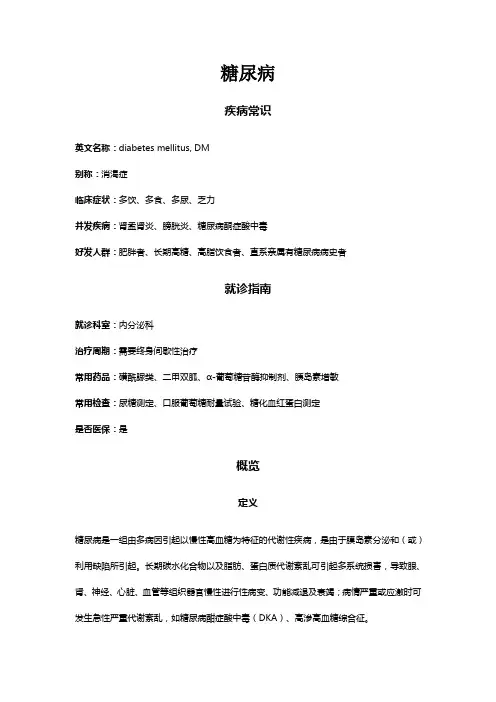
糖尿病疾病常识英文名称:diabetes mellitus, DM别称:消渴症临床症状:多饮、多食、多尿、乏力并发疾病:肾盂肾炎、膀胱炎、糖尿病酮症酸中毒好发人群:肥胖者、长期高糖、高脂饮食者、直系亲属有糖尿病病史者就诊指南就诊科室:内分泌科治疗周期:需要终身间歇性治疗常用药品:磺酰脲类、二甲双胍、α-葡萄糖苷酶抑制剂、胰岛素增敏常用检查:尿糖测定、口服葡萄糖耐量试验、糖化血红蛋白测定是否医保:是概览定义糖尿病是一组由多病因引起以慢性高血糖为特征的代谢性疾病,是由于膜岛素分泌和(或)利用缺陷所引起。
长期碳水化合物以及脂肪、蛋白质代谢紊乱可引起多系统损害,导致眼、肾、神经、心脏、血管等组织器官慢性进行性病变、功能减退及衰竭;病情严重或应激时可发生急性严重代谢紊乱,如糖尿病酣症酸中毒(DKA)、高渗高血糖综合征。
流行病学糖尿病是常见病、多发病,目前在全球范围内,糖尿病的患病率与发病率极攀升。
1.以2型糖尿病为例,2013年全国调查中2型糖尿病患病率为10.4%,男性高于女性(11.1%比9.6%)。
2.各民族间的糖尿病患病率存在较大差异:满族15.0%、汉族14.7%、维吾尔族12.2%、壮族12.0%、回族10.6%、藏族4.3%。
3.未诊断糖尿病比例较高。
2013年全国调查中,未诊断的糖尿病患者占总数的63%。
4.肥胖和超重人群糖尿病患病率显著增加,肥胖人群糖尿病患病率升高了2倍。
2013年按体质指数(BMI)分层显示,BMI<25 kg/m^2者糖尿病患病率为7.8%、25 kg/m2≤BMI<30 kg/m^2者患病率为15.4%,BMI≥30 kg/m^2者患病率为21.2%。
疾病分类我国目前采用WHO1999年的病因学分型体系,将糖尿病分为以下四大类:1.1型糖尿病:胰岛B细胞破坏,导致胰岛素绝对缺乏。
又分为免疫介导性和特发性(无自身免疫证据)。
2.2型糖尿病:以胰岛素抵抗为主伴胰岛素进行性分泌不足和以胰岛素进行性分泌不足为主伴胰岛素抵抗。

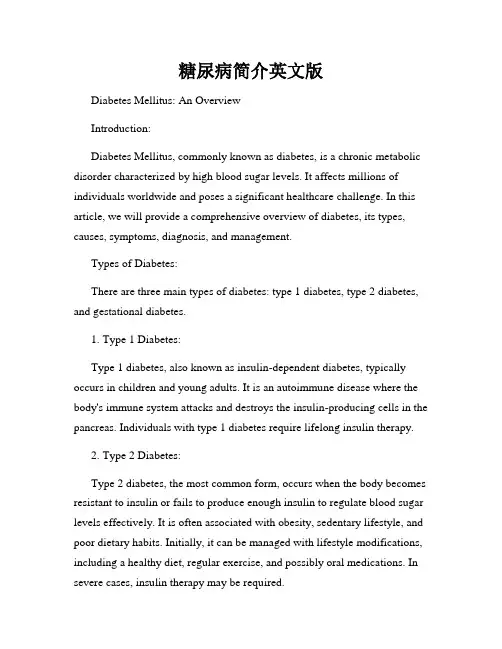
糖尿病简介英文版Diabetes Mellitus: An OverviewIntroduction:Diabetes Mellitus, commonly known as diabetes, is a chronic metabolic disorder characterized by high blood sugar levels. It affects millions of individuals worldwide and poses a significant healthcare challenge. In this article, we will provide a comprehensive overview of diabetes, its types, causes, symptoms, diagnosis, and management.Types of Diabetes:There are three main types of diabetes: type 1 diabetes, type 2 diabetes, and gestational diabetes.1. Type 1 Diabetes:Type 1 diabetes, also known as insulin-dependent diabetes, typically occurs in children and young adults. It is an autoimmune disease where the body's immune system attacks and destroys the insulin-producing cells in the pancreas. Individuals with type 1 diabetes require lifelong insulin therapy.2. Type 2 Diabetes:Type 2 diabetes, the most common form, occurs when the body becomes resistant to insulin or fails to produce enough insulin to regulate blood sugar levels effectively. It is often associated with obesity, sedentary lifestyle, and poor dietary habits. Initially, it can be managed with lifestyle modifications, including a healthy diet, regular exercise, and possibly oral medications. In severe cases, insulin therapy may be required.3. Gestational Diabetes:Gestational diabetes develops during pregnancy and usually resolves after childbirth. It occurs when hormonal changes during pregnancy lead to insulin resistance. If left uncontrolled, it can pose risks for both the mother and the baby. Proper monitoring and management are crucial to prevent complications.Causes of Diabetes:The causes of diabetes vary depending on the type:1. Type 1 Diabetes:The exact cause of type 1 diabetes is unknown, but it is believed to be a combination of genetic and environmental factors. Certain genes make individuals more susceptible to developing type 1 diabetes, and environmental triggers, such as viral infections, may initiate the autoimmune response.2. Type 2 Diabetes:Type 2 diabetes is primarily attributed to lifestyle factors, including obesity, physical inactivity, unhealthy eating habits, and genetic predisposition. Excessive body weight and abdominal fat accumulation increase insulin resistance, leading to elevated blood sugar levels.3. Gestational Diabetes:The hormonal changes during pregnancy are the main cause of gestational diabetes. These hormones can obstruct the action of insulin, resulting in high blood sugar levels.Symptoms of Diabetes:The symptoms of diabetes can vary, but some common signs include:1. Frequent urination2. Excessive thirst3. Unexplained weight loss4. Fatigue5. Blurred vision6. Slow healing of wounds7. Tingling sensation or numbness in the hands and feetDiagnosis of Diabetes:Diabetes can be diagnosed through various tests, including:1. Fasting Plasma Glucose Test: Measures blood sugar levels after fasting for at least 8 hours.2. Oral Glucose Tolerance Test: Measures blood sugar levels before and 2 hours after consuming a glucose-rich drink.3. Glycated Hemoglobin (HbA1c) Test: Measures average blood sugar levels over the past three months.Management of Diabetes:Diabetes management aims to keep blood sugar levels within the target range to prevent complications. It primarily involves:1. Healthy Eating: A well-balanced diet rich in fruits, vegetables, whole grains, lean proteins, and healthy fats is essential. Avoiding sugary foods and drinks helps control blood sugar levels.2. Regular Exercise: Engaging in physical activity for at least 150 minutes per week helps improve insulin sensitivity and regulate blood sugar levels.3. Medications: Depending on the type and severity of diabetes, oral medications, injectable drugs, or insulin may be prescribed to manage blood sugar levels effectively.4. Regular Monitoring: Regular monitoring of blood sugar levels and periodic check-ups with healthcare professionals are crucial for adjusting treatment plans and preventing complications.Conclusion:Diabetes Mellitus is a chronic condition requiring lifelong management. Understanding the types, causes, symptoms, diagnosis, and management strategies is crucial in effectively controlling blood sugar levels and preventing complications. By adopting a healthy lifestyle and working closely with healthcare professionals, individuals with diabetes can lead fulfilling lives and minimize the risks associated with the disease.。

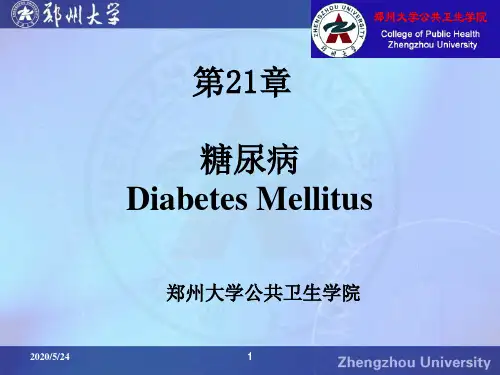
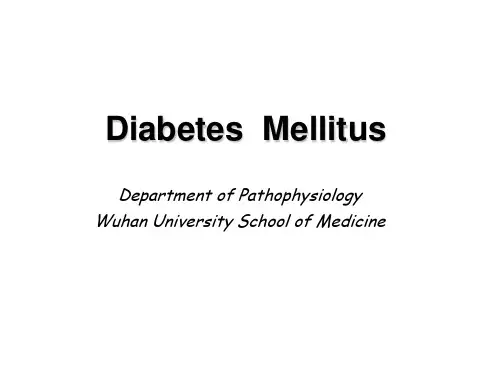

医学课件:糖尿病(英文版) xx年xx月xx日CATALOGUE 目录•糖尿病简介•糖尿病的病因•糖尿病的诊断•糖尿病的治疗•糖尿病的并发症•糖尿病的预防01糖尿病简介Diabetes Mellitus一种慢性、代谢性疾病,由于体内胰岛素绝对或相对不足,导致血糖过高,尿糖排出增加。
发病机制胰岛素抵抗、胰岛素分泌不足、葡萄糖利用障碍糖尿病的定义Type 1 diabetes胰岛素依赖型,由于自身免疫或不明原因导致胰岛素分泌不足。
Type 2 diabetes非胰岛素依赖型,由于生活方式、环境因素导致胰岛素抵抗或分泌不足。
糖尿病的分类糖尿病的症状高血糖、高血脂、高血压多尿、多饮、多食、体重减轻神经病变、心脑血管病变、糖尿病足等视力模糊、伤口愈合缓慢02糖尿病的病因遗传因素类型1糖尿病是一种自身免疫性疾病,受遗传因素的影响,易感人群在病毒感染、化学物质等多种因素的作用下,诱发机体免疫反应,导致胰岛细胞的损伤和破坏。
环境因素环境因素在类型1糖尿病的发病中也起到重要作用,如病毒感染、化学物质等。
类型1糖尿病的病因类型2糖尿病的发生与遗传有关,家族中有患病史的人群患病风险较高。
遗传因素环境因素是类型2糖尿病发病的重要诱因,主要包括缺乏运动、饮食不合理、肥胖、吸烟、饮酒等。
环境因素类型2糖尿病的病因遗传因素妊娠期糖尿病与遗传有关,家族中有糖尿病史的女性患病风险较高。
环境因素妊娠期糖尿病的发生还与多种环境因素有关,如孕期饮食不合理、缺乏运动、肥胖、妊娠期年龄过大等。
妊娠期糖尿病的病因03糖尿病的诊断针对高危人群,如家族遗传史、肥胖、高血压、血脂异常等,应定期进行糖尿病筛查。
糖尿病的筛查常规筛查出现多饮、多尿、多食和不明原因的体重减轻等典型症状,应尽早就医,接受糖尿病筛查。
临床筛查针对妊娠期、老年人、有慢性肾脏疾病或心血管疾病史等特定人群,应根据医生建议进行筛查。
特殊筛查空腹血糖空腹血糖≥7.0 mmol/L,或OGTT试验2小时血糖≥11.1 mmol/L,或随机血糖≥11.1mmol/L,同时伴有典型症状,即可诊断为糖尿病。
英文介绍糖尿病Diabetes is a chronic medical condition that affects how your body turns food into energy. There are two main types of diabetes: type 1 and type 2. In type 1 diabetes, the body does not produce insulin, a hormone necessary for regulating blood sugar levels. This type of diabetes is usually diagnosed in children and young adults, and it requires lifelong insulin therapy. Type 2 diabetes, on the other hand, occurs when the body becomes resistant to insulin or does not produce enough insulin. This type of diabetes is more common in adults and is often linked to lifestyle factors such as obesity and lack of physical activity.One of the key symptoms of diabetes is high blood sugar levels, which can lead to a range of complications if not properly managed. These complications can include heart disease, stroke, kidney disease, nerve damage, and vision problems. It is important for individuals with diabetes to monitor their blood sugar levels regularly and follow atreatment plan prescribed by their healthcare provider. This may include taking medication, following a healthy diet, exercising regularly, and monitoring blood sugar levels.Diabetes management also involves making lifestyle changes to help control blood sugar levels and prevent complications. This can include maintaining a healthy weight, eating a balanced diet rich in fruits, vegetables, and whole grains, and getting regular physical activity. It is also important to avoid smoking and limit alcohol consumption, as these habits can worsen diabetes symptoms and increase the risk of complications. Additionally, individuals with diabetes should work closely with their healthcare team to develop a personalized treatment plan that meets their needs and helps them achieve their health goals.In addition to lifestyle changes, individuals with diabetes may also need to take medication to help manage their condition. This can include insulin injections, oral medications, or other treatments to help control bloodsugar levels. It is important for individuals with diabetes to take their medication as prescribed and to monitor their blood sugar levels regularly to ensure that their condition is well-managed. In some cases, individuals with diabetes may also need to use devices such as insulin pumps or continuous glucose monitors to help monitor and control their blood sugar levels.Overall, diabetes is a complex and chronic condition that requires ongoing management and care. By making lifestyle changes, following a treatment plan, and working closely with healthcare providers, individuals with diabetes can effectively manage their condition and reduce the risk of complications. It is important for individuals with diabetes to stay informed about their condition, seek support from healthcare providers and loved ones, and take an active role in their own health to live a full and healthy life with diabetes.。